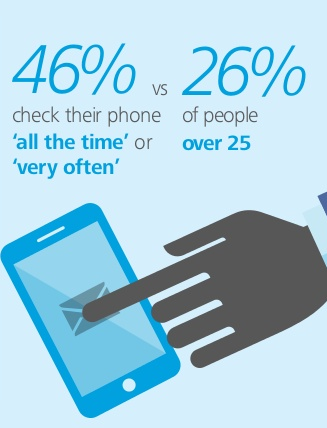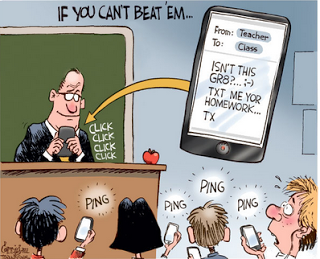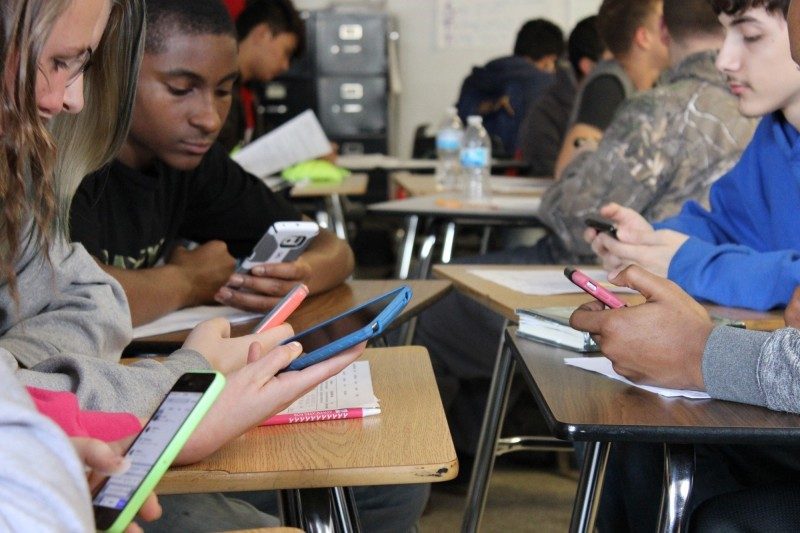Something that barely existed 12 years ago is now so essential to life that few people can imagine life without it. What is it? It’s the smartphone. According to Deloitte, young adults aged 18 to 24 are the most distracted by their devices: 31% check their phone within five minutes of waking, 27% within five minutes of preparing to sleep and 46% check their phone “all the time” or “very often.”[1] Coming face-to-face with this reality, it is obvious why teachers are reporting that smartphones, as well as other mobile devices such as laptops and tablets, are a major distraction for students in class. On the other hand, many students use their smartphones to do academic work in class.

Students’ personal mobile technologies, mainly smartphones and, to a lesser extent, laptops and tablets, have permeated Dawson’s classes. One possible approach to deal with the potential distraction caused by these devices, adopted by some teachers at the college, is to ban outright their presence in class. Another approach has been to embrace their presence and to identify teaching practices that foster appropriate use of personal mobile technologies by students in class. That’s what we at the Adaptech Research Network decided to examine in our “if you can’t beat them, join them” research.
In 2017, the Adaptech Research Network completed a research study funded by the Fonds de recherche du Québec – Société et culture (FRQSC) titled Student and Faculty Perspectives on Excellence in ICT and Elearning Use in College.[2] One of the significant findings was that the majority of students want their teachers to allow them to use their laptops, tablets and smartphones in class. Regrettably, at that time we failed to ask students how they used these devices.
… the majority of students want their teachers to allow them to use their laptops, tablets and smartphones in class.
To answer this question, in Fall 2018 we began a project funded by a grant from Dawson’s Support the Academic Success of Students with Special Needs (S051). The goal was to understand the perspectives of Dawson College professionals and Social Science teachers and students, with and without disabilities, about the use of students’ personal mobile technologies in class.
To accomplish this, we conducted four focus groups and compiled the information to gain a better understanding about how personal mobile technologies are used in class to help students learn. We also asked about the use of these devices for off-task activities. As you can imagine, the teachers, the professionals and the students — including those with disabilities — had a lot to say. Here we’d like to share some of the participants’ comments and then make suggestions about how teachers can promote the appropriate use of students’ personal mobile technologies in class.
Students – Inappropriate uses of mobile devices in class
To no one’s surprise, students use their devices for inappropriate activities, especially when they are bored in class. The most common off-task use reported was texting as well as checking Facebook, WhatsApp, Instagram and Snapchat. There were many other examples, such as using Google Search to look up “random” things, play computer games, shop online, book vacations and watch videos in class. On a slightly more positive note, although still inappropriate for class, students sometimes used their mobile devices to do homework, check their grades and complete assignments for other courses.
Students – Appropriate uses of mobile devices in class
Some participants reported that if teachers saw students using their smartphones in class it was automatically assumed that they were off-task. Some students felt that their teachers failed to understand legitimate uses and assumed they were texting. Yet, participants noted that students also used their personal mobile devices for note-taking and for taking pictures of PowerPoint slides and diagrams on the blackboard and whiteboard. Mobile devices facilitated note-taking by helping students follow along with the PowerPoint in class and by allowing them to record lectures using an app such as Voice Memo. Students also used several Google features, including Google Search, to look up concepts related to course material, Google Translate to access dictionaries and Google Docs for group work.
…if teachers saw students using their smartphones in class it was automatically assumed that they were off-task.
Why do teachers prohibit the use of mobile devices?
Some teachers may dislike technology because they do not understand how it can facilitate academic tasks. However, there were also other important concerns expressed not only by teachers, but also by some of the students and the professionals. Some participants in each of the four groups saw smartphones, laptops and tablets as a distraction for students and teachers, especially when they were buzzing or when there was light flashing. As well, they felt that the use of these devices was rude or disrespectful when someone was speaking to the class. Participants also noted that use of personal mobile technologies hindered class discussions and discouraged participation in general. Furthermore, participants expressed genuine concern that failure on the part of students to pay attention, because of multitasking, could result in poor academic performance.
Several participants brought up the research of Mueller and Oppenheimer, which showed that taking notes by hand resulted in better learning than notes taken on a mobile device.[3] However, a recent large study showed no significant differences between the Grade Point Averages of students who used different note-taking methods (paper, laptop, smartphone, tablet).[4] Moreover, excellent resources exist to help teach effective note-taking using personal mobile technologies.[5]
How do teachers use mobile devices in class?
Some Dawson teachers are already taking advantage of students’ personal mobile devices. The use of polling apps, such as Kahoot and Poll Everywhere, seem to be very popular and well liked. In some cases, to make class more interactive, students were told to research questions using their mobile devices and send their responses immediately to the teacher. There was even a teacher who brought Alexa, a digital assistant that responds to voice queries and can gather information from various sources, to answer questions. This can provide students with an interesting learning opportunity on how to evaluate the credibility of information found online. Mobile devices were also used to facilitate group work in class using Google Docs.

Mobile devices were also used with hardware available in class. For example, class notes written on students’ devices could be flipped directly onto a SMART Board. To assure that students have access to the information presented in class for studying, some teachers provided voice-overs of their lectures while presenting PowerPoint slides; they then posted this online, so students could listen anytime on their devices.
Some of the examples of apps provided by focus group participants were discipline-specific, such as smartphones’ built-in geography tools (e.g., maps and compass) and Khan Academy for math. Khan Academy is an online service with a set of online tools to tutor students on various subjects. Participants also reported that access to personal mobile devices in class could facilitate student participation in class. For example, students could download high-resolution images, materials from course websites, digital textbooks and other material to be used in class discussion. These are just some examples of current teaching practices. But if you talk with colleagues, there is a lot more happening out there.
A note about students with disabilities
Students with disabilities used their personal mobile technologies for the same activities, both appropriate and inappropriate, as their peers without disabilities. However, they also used them for other essential reasons. A popular press piece in the Huffington Post is titled, “When you talk about banning laptops, you throw disabled students under the bus,” because for some students with disabilities, studying and attending class without their personal mobile devices is simply not possible.[6]
…for some students with disabilities, studying and attending class without their personal mobile devices is simply not possible.
Note that today’s Apple, Android, and Windows mobile devices all have powerful built-in features that allow users to perform a multiplicity of tasks such as bolding text, providing hearing aid compatibility, reading text and menus aloud, contrasting colour, and magnifying the screen (see www.adaptech.org/en/downloads). There are also applications that can help students achieve academically. These include apps, such as Mindly, which helps to brainstorm and create schematic maps of ideas. For students who are easily distracted in class, several apps can help them maintain their focus. For example, Focus Lock allows students to select the apps they want to lock out and set a timer for when the apps will unlock and work again. Similarly, the Forest app, in which the student plants a virtual tree that continues to grow as long as the student doesn’t use the mobile device, helps students focus in class. If the student uses the device, the tree dies. For students who are anxious, texting, which is normally a distraction in class, can be used to get in touch with someone who can help in case of a panic attack. Students may also listen to music while working on their own in class to calm themselves down.
Class management strategies for mobile devices
If students, professionals and teachers are aware of the possibilities of using mobile technologies in academically appropriate ways in class, does this mean that management strategies for these devices are no longer necessary? Unfortunately, this is overly optimistic and not the case. So how do teachers manage the use of students’ personal mobile technologies in class? Some teachers are very restrictive and do not allow students to use them in class, sometimes asking students to leave the class, other times publicly shaming them. Others are more flexible and allow the use of mobile devices so long as students are not disturbing anyone or are seated in a designated area of the classroom. Teachers sometimes tell students when they can and cannot use their devices (e.g., not permitted during student presentations). Many participants noted that it was appreciated when teachers clearly explained to students why they were not allowed to use mobile devices in class. However, participants, especially the students, also felt that if they were not distracting others, the decision should be left up to them. To quote a student, “We can drink and vote. Are you really going to try to tell us that we cannot use our smartphones in class?”
To conclude
One student’s comment about teachers was the following: “The teachers see the use of mobile technology as something else to manage in class. Saying no to mobile technologies is just easier.” The student may have a point, because no one in our groups wanted to take up valuable teaching time on policing the use of mobile devices. There is likely no easy answer to managing their use. However, several participants noted that students appreciated teachers who took the time to explain their philosophy regarding the use of personal mobile devices and who allowed their use for academic tasks. Indeed, students were honest about being off-task with their phones as were teachers when they shared their frustrations regarding this behaviour.
“Since smartphones are not going anywhere, should teachers not find a way to use smartphones as a tool in class and integrate these into their teaching?”
A student participant summarized the issue quite aptly: “Since smartphones are not going anywhere, should teachers not find a way to use smartphones as a tool in class and integrate these into their teaching?” The real question is: How can students’ personal technologies be used effectively in college? That’s the next step in our research and we’ll be looking for your creative ideas.
Footnotes
[1] Deloitte, “How do today’s students use mobiles?” (2016). Retrieved from https://www2.deloitte.com/uk/en/pages/public-sector/articles/how-do-todays-students-use-mobiles.html.
[2] For further information see C.S. Fichten et al., “Information and communication technologies: views of Canadian college students and ‘excellent’ professors” Journal of Education and Training Studies 6:9 (2018): 1-12. doi:10.11114/jets.v6i9.3390.
[3] P.A. Mueller and D.M. Oppenheimer, “The pen is mightier than the keyboard: advantages of longhand over laptop note taking” Psychological Science 25:6 (2014): 1159-1168. doi:10.1177/0956797614524581.
[4] D.L. Gurley, The relationship between note-taking method and grade point average when controlling for ACT score and self-regulation ability in undergraduate students, Ph. D. thesis, University of Mississippi, 2018, ProQuest Dissertations and Theses database, UMI No. 10747687.
[5] J. Siegel, “Teaching lecture notetaking with authentic materials” ELT Journal (2018), ccy. doi:10.1093/elt/ccy031.
[6] K.R.G. Pryal and J. Jack, “When you talk about banning laptops, you throw disabled students under the bus” Huffington Post, 27 November 2017. Retrieved from https://www.huffingtonpost.com/entry/when-you-talk-about-banning-laptops-you-throw-disabled_us_5a1ccb4ee4b07bcab2c6997d.
Further reading
Crompton, H., & Burke, D. “The use of mobile learning in higher education: a systematic review” Computers & Education 123 (2018): 53-64. doi:10.1016/j.compedu.2018.04.007
Leyden, Andrea. “40 Uses for smartphones in school” GoConqr, 19 February 2018, https://www.goconqr.com/en/examtime/blog/40-uses-for-smartphones-in-school/.
Morehead, K., et al., “Note-taking habits of the 21st century college students: implications for student learning, memory, and achievement” Memory (2019). Advance online publication. doi:10.1080/09658211.2019.1569694.
Reed, Matt. “Writing papers on phones: is a smartphone a necessity for college students today?” Inside Higher Ed, 3 December 2018, https://www.insidehighered.com/blogs/confessions-community-college-dean/writing-papers-phones.



